1995 CHEVROLET CORVETTE service
[x] Cancel search: servicePage 2 of 386
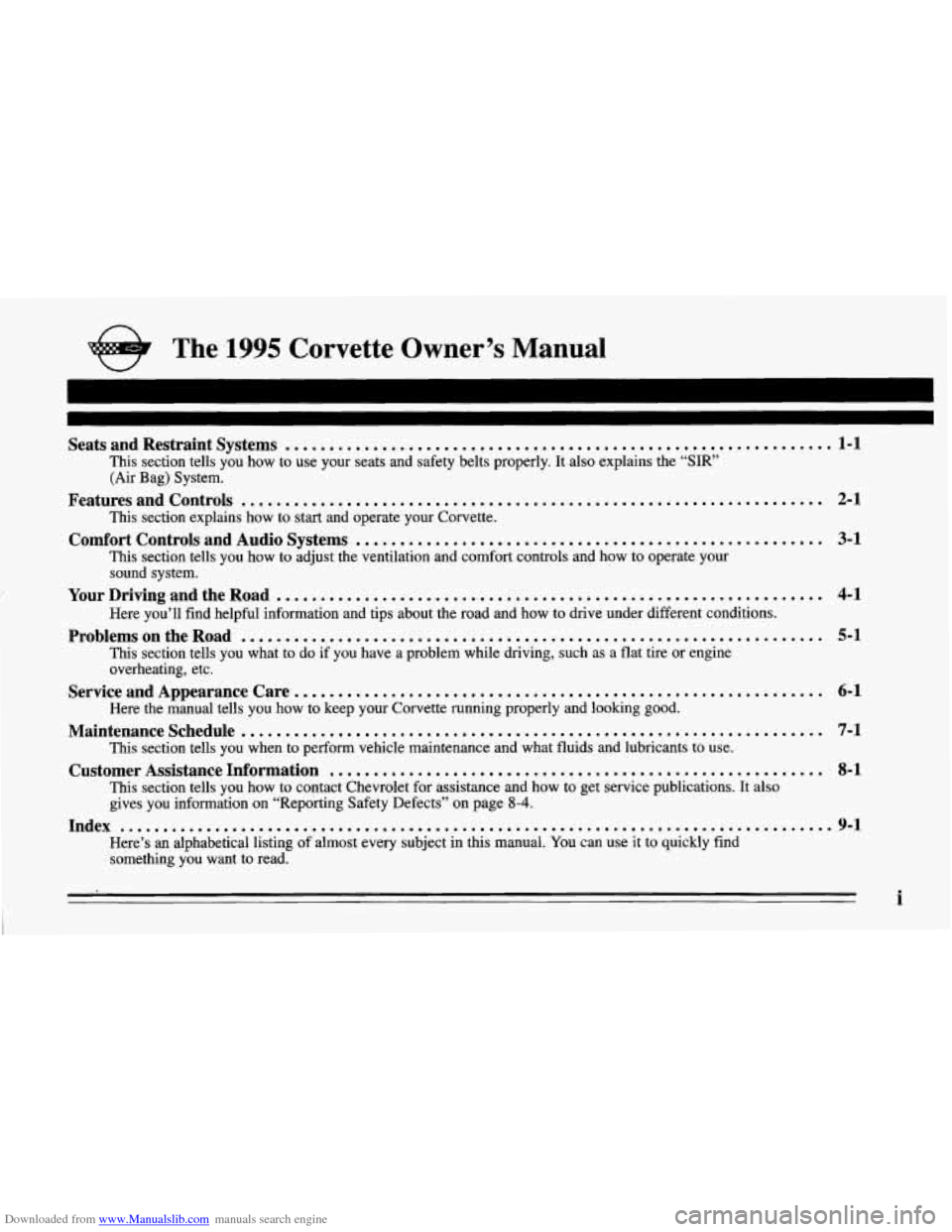
Downloaded from www.Manualslib.com manuals search engine n
The -1995 Corvette Owner’s Manual
Seats and Restraint Systems .............................................................. 1-1
This section tells you how to use your seats and safety belts properly. It also explains the “SIR’
(Air Bag) System.
This section explains how to start and operate your Corvette.
This section tells you how to adjust the ventilation and comfort controls and how
to operate your
sound system.
YourDrivingandtheRoad ..............................................................
Here you’ll find helpful information and tips about the road and how to drive under different conditions.
This section tells you what to do if
you have a problem while driving, such as a flat tire or engine
overheating, etc.
Here the manual tells
you how to keep your Corvette running properly and looking good.
Maintenanceschedule ..................................................................
This section tells you when to perform vehicle maintenance and what fluids and lubricants to use.
Customer Assistance Information ........................................................
This section tells you how to contact Chevrolet for assistance and how to get service publications. It also
gives you information on “Reporting Safety Defects” on page
8-4.
FeaturesandControls ..................................................................
Comfort Controls and Audio Systems .....................................................
ProblemsontheRoad ..................................................................
ServiceandAppearanceCare ............................................................
2-1
3-1
4-1
5-1
6- 1
7-1
8-1
Index ........................................................................\
......... 9-1
Here’s an alphabetical listing of almost every subject in this manual. You can use it to quickly find
something you want to read.
i
Page 3 of 386
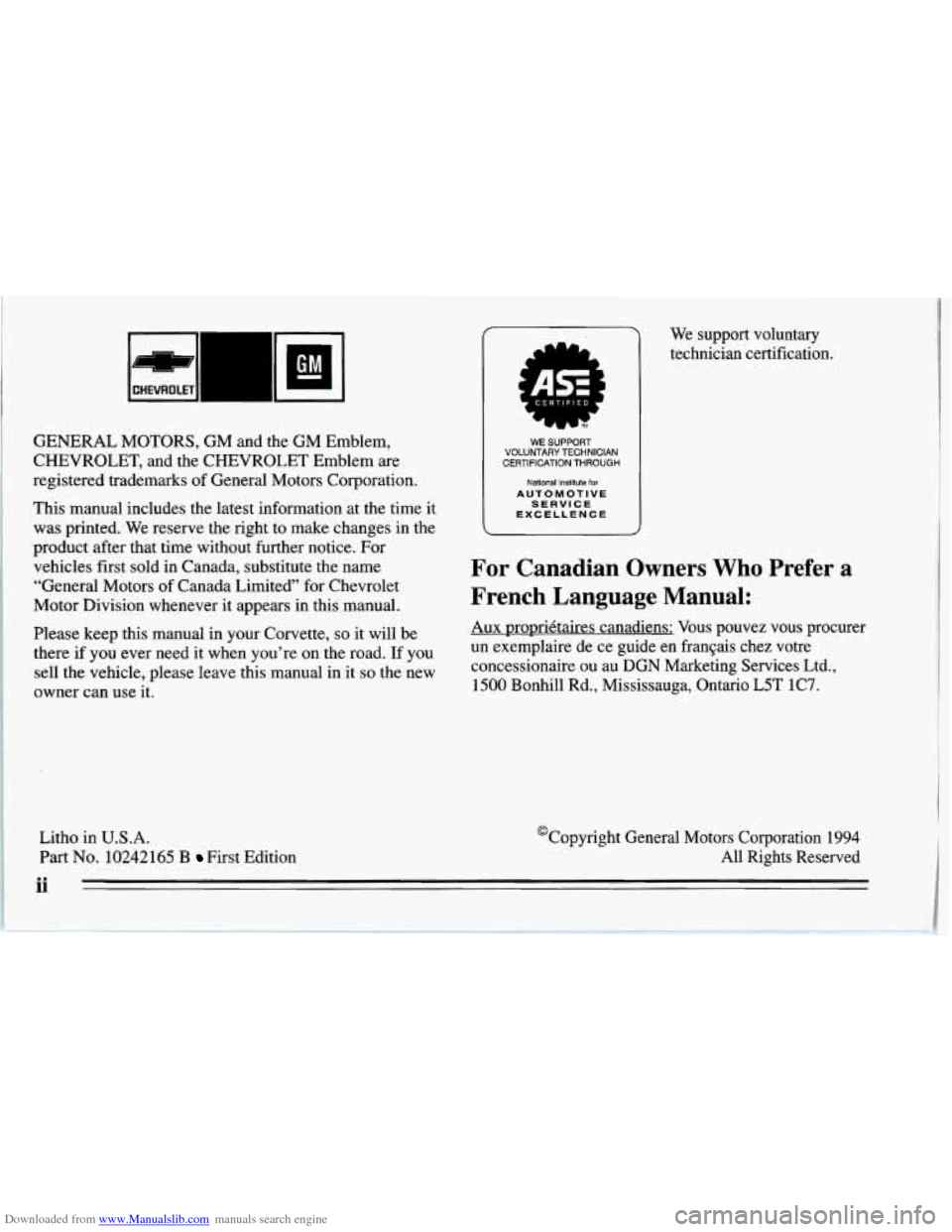
Downloaded from www.Manualslib.com manuals search engine k-~, CHEVROLET In1
GM -
GENERAL MOTORS, GM and the GM Emblem,
CHEVROLET, and the CHEVROLET Emblem
are
registered trademarks of General Motors Corporation.
This manual includes the latest information at the time it
was printed. We reserve the right to make changes in the
product after that time without further notice. For
vehicles first sold in Canada, substitute the name
“General Motors of Canada Limited” for Chevrolet
Motor Division whenever it appears in this manual.
Please keep this manual in your Corvette,
so it will be
there if you ever need it when you’re on the road. If you
sell the vehicle, please leave this manual in it
so the new
owner can use it.
Litho in U.S.A.
Part
No. 10242165 B First Edition
I
VOLUNTARY TECHNICIAN WE SUPPORT
CERTIFICATION THROUGH
AUTOMOTIVE National Institute for
EXCELLENCE SERVICE
We support voluntary
technician certification.
For Canadian Owners Who Prefer a
French Language Manual:
Aux proprietaires canadiens: Vous pouvez vous procurer
un exemplaire de ce guide en franqais chez votre
concessionaire ou au
DGN Marketing Services Ltd.,
1500 Bonhill Rd., Mississauga, Ontario L5T lC7.
@Copyright General Motors Corporation 1994
All Rights Reserved
Page 32 of 386

Downloaded from www.Manualslib.com manuals search engine What will you see after an air bag inflates?
After the air bag inflates, it quickly deflates. This occurs
so quickly that some people may not even realize the air
bag inflated. Some components of the air bag module in
the steering wheel hub for the driver’s air bag, or the
instrument panel for the passenger’s bag, will be hot for
a short time, but the part of the bag that comes into
contact with you will not be hot to the touch. There will
be some smoke and dust coming from vents in the
deflated air bags. Air bag inflation will not prevent the
driver from seeing or from being able to steer the
vehicle, nor will it stop people from leaving the vehicle. In many crashes severe enough to
inflate an air bag,
windshields are broken by vehicle deformation.
Additional windshield breakage may also occur from the
passenger air bag.
0
0
0
The air bags are designed to inflate only once. After
they inflate, you’ll need some new parts for your air
bag system. If you don’t get them, the air bag system
won’t be there to help protect you in another crash.
A new system will include air bag modules and
possibly other parts. The service manual for your
vehicle covers the need to replace other parts.
Your vehicle is equipped with a diagnostic module,
which records information about the air bag system.
The module records information about the readiness
of the system, when the sensors are activated and
driver’s safety belt usage at deployment.
Let only qualified technicians work
on your air bag
system. Improper service can mean that your air bag
system won’t work properly. See your dealer for
service.
1-21
Page 33 of 386

Downloaded from www.Manualslib.com manuals search engine NOTICE:
If you damage the cover for the driver’s or the
passenger’s air bag, they may not work properly.
You may have to replace the air bag module in
the steering wheel or both the air bag module and
the instrument panel for the passenger’s
air bag.
Do not open or break the air bag covers.
Servicing Your Air Bag-Equipped Corvette
Air bags affect how your Corvette should be serviced.
There are parts
of the air bag system in several places
around your vehicle. You don’t want the system to
inflate while someone is working on your vehicle. Your
Chevrolet dealer and the
1995 Corvette Service Manual
have information about servicing your vehicle and the
air bag system. To purchase a service manual, see
“Service Publications” in the Index.
The air bag system does not need regular maintenance.
1-22
Page 48 of 386
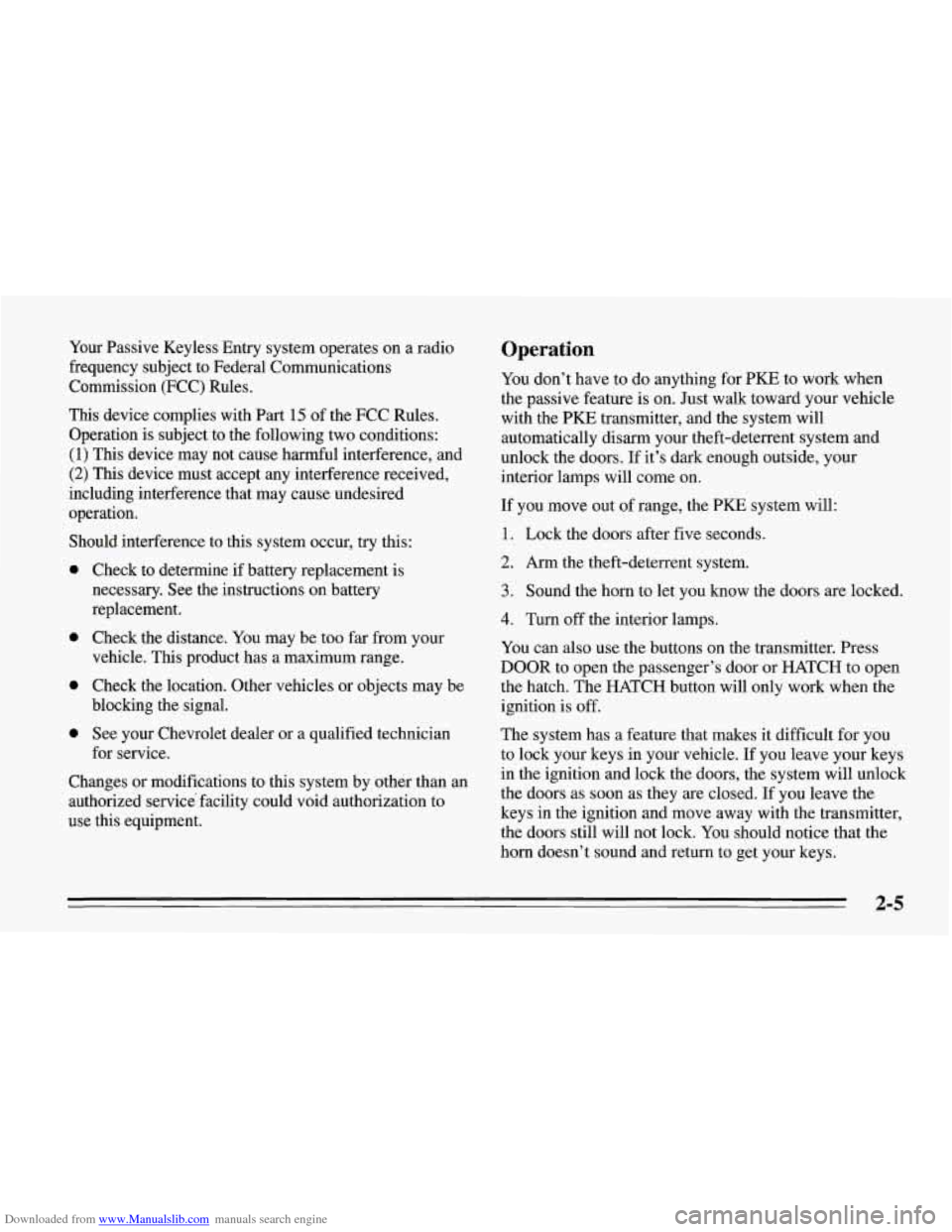
Downloaded from www.Manualslib.com manuals search engine Your Passive Keyless Entry system operates on a radio
frequency subject to Federal Communications
Commission (FCC) Rules.
This device complies with Part
15 of the FCC Rules.
Operation is subject to the following two conditions:
(1) This device may not cause harmful interference, and
(2) This device must accept any interference received,
including interference that may cause undesired
operation.
Should interference to this system occur, try this:
0
0
a
0
Check to determine if battery replacement is
necessary. See the instructions
on battery
replacement.
Check the distance. You may be too far from your
vehicle. This product has a maximum range.
Check the location. Other vehicles or objects may be
blocking the signal.
See your Chevrolet dealer or a qualified technician
for service.
Changes or modifications to this system by other than an
authorized service facility could void authorization to
use this equipment.
Operation
You don’t have to do anything for PKE to work when
the passive feature is on. Just walk toward your vehicle
with the
PKE transmitter, and the system will
automatically disarm your theft-deterrent system and
unlock the doors.
If it’s dark enough outside, your
interior lamps will come on.
If you move out of range, the PKE system will:
1. Lock the doors after five seconds.
2. Arm the theft-deterrent system.
3. Sound the horn to let you know the doors are locked.
4. Turn off the interior lamps.
You can also use the buttons on the transmitter. Press
DOOR to open the passenger’s door or HATCH to open
the hatch. The HATCH button will only work when the
ignition is off.
The system has a feature that makes it difficult for you
to lock your keys in your vehicle. If you leave your keys
in the ignition and lock the doors, the system will unlock
the doors as soon as they are closed. If you leave the
keys in the ignition and move away with the transmitter,
the doors still will not lock. You should notice that the
horn doesn’t sound and return to get your keys.
Page 57 of 386
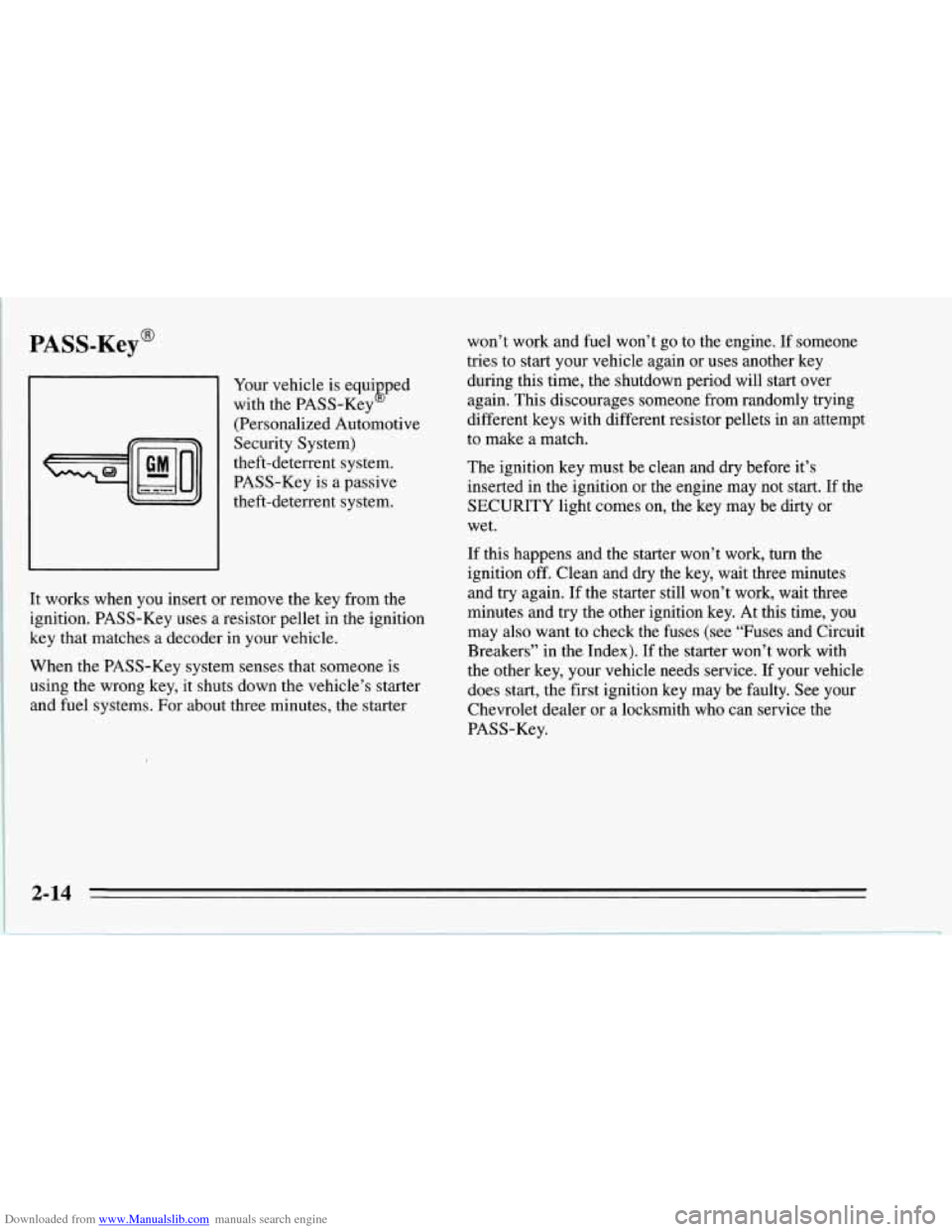
Downloaded from www.Manualslib.com manuals search engine PASS-Key@
Your vehicle is equi ped
with the PASS-Key
(Personalized Automotive
Security System)
theft-deterrent system.
PASS-Key is a passive
theft-deterrent system.
It works when you insert or remove the key from the
ignition. PASS-Key uses a resistor pellet in the ignition
key that matches a decoder in your vehicle.
When the PASS-Key system senses that someone is
using the wrong key, it shuts down the vehicle’s starter
and fuel systems. For about three minutes, the starter won’t work and
fuel won’t go to the engine. If someone
tries to start your vehicle again or uses another key
during this time, the shutdown period will start over
again. This discourages someone from randomly trying
different keys with different resistor pellets in an attempt
to make a match.
The ignition key must be clean and dry before it’s
inserted in the ignition or the engine may not start. If the
SECURITY light comes on, the key may be dirty or
wet.
If this happens and the starter won’t work, turn the
ignition
off. Clean and dry the key, wait three minutes
and
try again. If the starter still won’t work, wait three
minutes and try the other ignition key. At this time, you
may also want to check the fuses (see “Fuses and Circuit
Breakers” in the Index). If the starter won’t work with
the other key, your vehicle needs service.
If your vehicle
does start, the first ignition key may be faulty. See your
Chevrolet dealer or a locksmith who can service the
PASS-Key.
2-14
Page 58 of 386
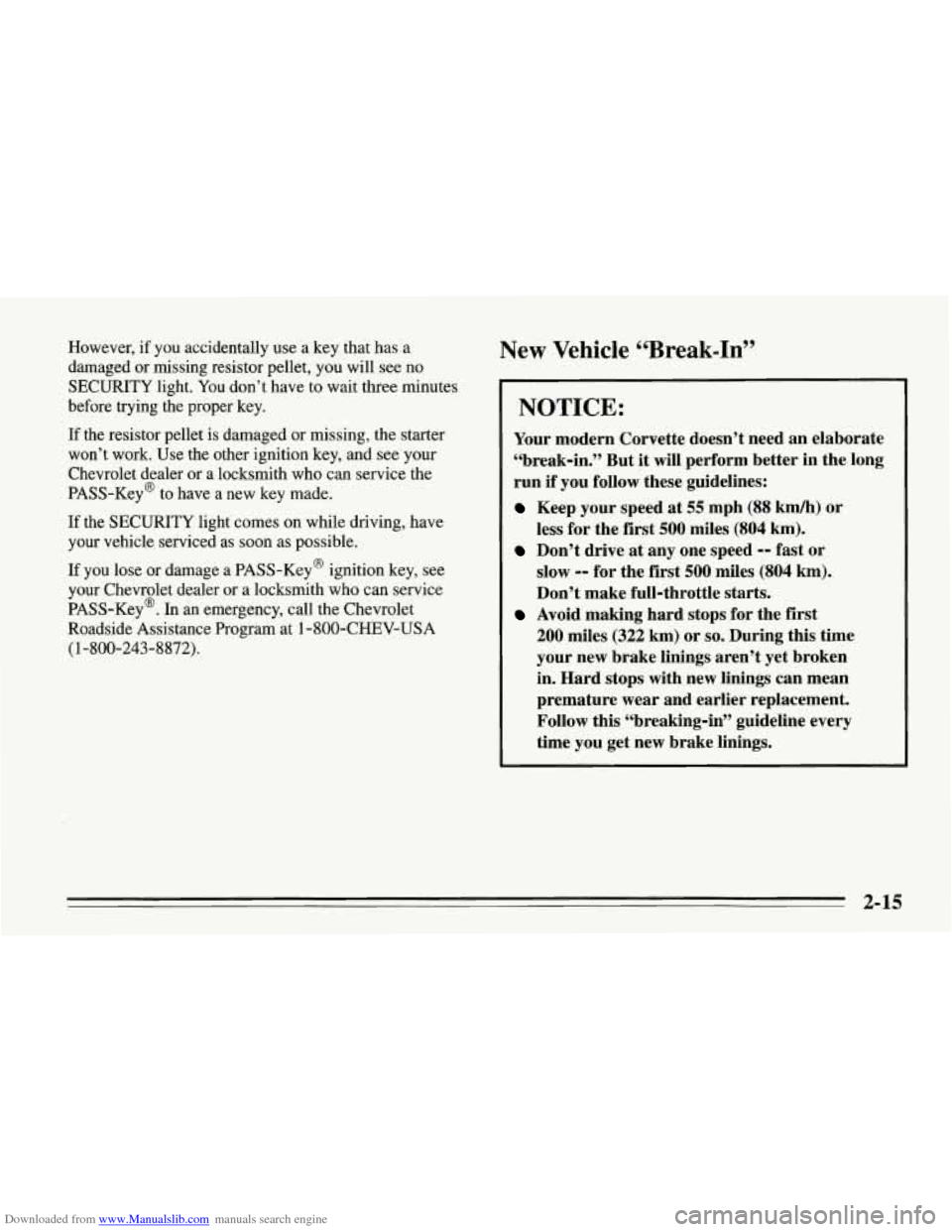
Downloaded from www.Manualslib.com manuals search engine However, if you accidentally use a key that has a
damaged or missing resistor pellet, you will see no
SECURITY light. You don’t have to wait three minutes
before trying the proper key.
If the resistor pellet is damaged or missing, the starter
won’t work. Use the other ignition key, and
see your
Chevrolet dealer or a locksmith who can service the
PASS-Key@ to have a new key made.
If the SECURITY light comes on while driving, have
your vehicle serviced as
soon as possible.
If you lose or damage a PASS-Key@ ignition key, see
your Chevrolet dealer or a locksmith who can service
PASS-Key? In an emergency, call the Chevrolet
Roadside Assistance Program at
1 -800-CHEV-USA
(1-800-243-8872).
New Vehicle “Break-In”
NOTICE:
Your modern Corvette doesn’t need an elaborate
“break-in.” But
it will perform better in the long
run if you follow these guidelines:
Keep your speed at 55 mph (88 km/h) or
less for the
first 500 miles (804 km).
Don’t drive at any one speed -- fast or
slow
-- for the first 500 miles (804 km).
Don’t make full-throttle starts.
200 miles (322 km) or so. During this time
your new brake linings aren’t yet broken
in. Hard stops with new linings can mean
premature wear and earlier replacement.
Follow this “breaking-in” guideline every
time you get new brake linings.
Avoid making hard stops for the first
2-15
Page 60 of 386

Downloaded from www.Manualslib.com manuals search engine Key Release Button
If you have a manual transmission, your ignition lock
has a key release button. You must press the button
before you can take your key out of the ignition lock.
~ NOTICE:
If your key seems stuck in LOCK and you can’t
turn it, be sure it is all the
way in. If it is, then
turn the steering wheel left and right while you
turn the key hard. But turn the key only with
your hand. Using
a tool to force it could break
the key or the ignition switch.
If none of this
works, then your vehicle needs service.
2-17